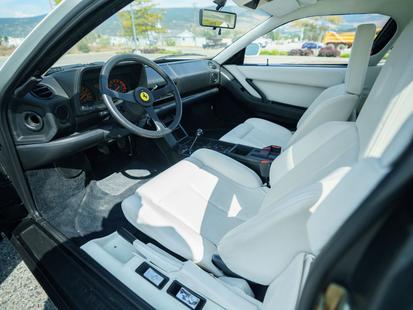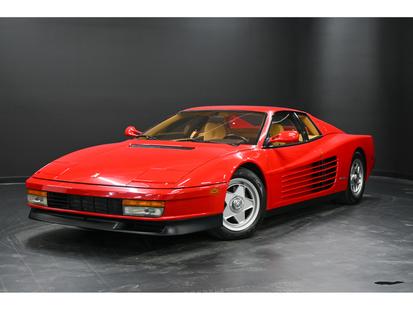The Ferrari Testarossa is an iconic sports car that epitomizes the exuberance and flair of 1980s automotive design. Known for its striking design and powerful performance, the Testarossa has been one of Ferrari's most memorable models, capturing the imagination of car enthusiasts worldwide. Positioned as a high-performance luxury sports car, it was a symbol of opulence and speed, setting the standard for future Ferrari models.
History and Background
The Ferrari Testarossa debuted at the 1984 Paris Auto Show, immediately capturing attention with its dramatic styling and groundbreaking engineering. Designed to replace the Berlinetta Boxer, the Testarossa offered improvements in both aesthetics and performance, becoming a flagship model for Ferrari.
The car's name, which translates to "red head" in Italian, references the red-painted cam covers on the engine. Over its production run, the Testarossa underwent several updates, including the 512 TR and the F512 M, which further enhanced its performance and appeal.
Key Dates:
- 1984: Ferrari Testarossa launched at the Paris Auto Show
- 1991: Introduction of the improved 512 TR model
- 1994: Final iteration, the F512 M, introduced
- 1996: End of Testarossa production

Ferrari TestaRossa 1986 PC1688
$289,900
11,335 miles

Pre-Owned 1989 Ferrari Testarossa Rare White on White For Sale By August Motorcars
$202,159
21,814 miles

1987 Ferrari Testarossa
$164,995
34,433 miles
Performance and Handling
| Variant | Engine | Power | 0-60 | Top Speed | Fuel Economy |
|---|---|---|---|---|---|
| Testarossa | 4.9L flat-12 | 385 hp | 5.2s | 180 mph | 12/17 mpg |
| 512 TR | 4.9L flat-12 | 428 hp | 4.8s | 195 mph | 11/16 mpg |
| F512 M | 4.9L flat-12 | 440 hp | 4.7s | 196 mph | 10/15 mpg |
Interior and Comfort
| Feature | Base | Mid | Top |
|---|---|---|---|
| Leather Upholstery | ✓ | ✓ | ✓ |
| Air Conditioning | ✓ | ✓ | ✓ |
| Power Windows | ✓ | ✓ | ✓ |
| Premium Audio | - | ✓ | ✓ |
Technology and Features
Technology by Model Year:
- 1984: Basic analog instrumentation
- 1991: Improved interior ergonomics with 512 TR
- 1994: Updated dashboard layout in F512 M
Infotainment System:
- Screen size: N/A
- Features: Basic radio unit with cassette player (later models)
- Connectivity: None
Driver Assistance Features:
- Standard: None
- Optional: None
Safety
While the Ferrari Testarossa was built for performance, safety features were not as advanced as modern standards. It lacked many of the driver assistance technologies we expect today, focusing instead on the purity of the driving experience.
Safety Ratings:
- NHTSA Rating: Not rated
- IIHS Rating: Not rated
Safety Features:
- Standard: Seatbelts, basic structural integrity
- Optional: None
Value for Money
| Year | Condition | Price Range |
|---|---|---|
| 1984 | Excellent | $120,000-$150,000 |
| 1991 | Good | $110,000-$130,000 |
| 1994 | Fair | $90,000-$110,000 |
Running Costs:
Owning a Ferrari Testarossa involves significant running costs, from high fuel consumption to expensive maintenance. However, for many enthusiasts, the costs are justified by the car's exceptional performance and heritage.
- Fuel Economy: 12 city / 17 highway / 14 combined
- Service Intervals:
- Oil Change: Every 3,000 miles
- Major Service: Every 15,000 miles
- Common Repair Costs:
- Clutch Replacement: $5,000-$7,000
- Timing Belt Service: $7,000-$10,000
Known Issues by Year:
- 1984: Electrical system issues
- 1991: Oil leaks
- 1994: Cooling system problems
Competitor Comparison
Competitor 1: Lamborghini Countach
- Market Position: The Countach was Lamborghini's flagship model during the same era, known for its radical styling and V12 engine.
- Features Comparison: Both cars featured powerful engines and exotic designs, but the Countach was more extreme in appearance and less comfortable.
- Price Comparison: Historically, the Countach has been priced similarly to the Testarossa, though specific models vary.
- Running Costs: The Countach shares similar maintenance challenges and costs, with high fuel consumption and expensive parts.
Competitor 2: Porsche 911 Turbo (930)
- Market Position: The Porsche 911 Turbo offered a more practical alternative, with a rear-engine layout and everyday usability.
- Features Comparison: While less powerful than the Testarossa, the 911 Turbo excelled in handling and featured advanced turbocharging technology.
- Price Comparison: Generally more affordable than the Testarossa, though prices for well-preserved models are rising.
- Running Costs: Slightly more economical but still expensive compared to standard vehicles, with less costly regular maintenance.
Competitor 3: Aston Martin V8 Vantage
- Market Position: The V8 Vantage provided a British luxury sports car experience, focusing on elegance and refinement.
- Features Comparison: While less performance-oriented than the Testarossa, it offered superior comfort and luxury features.
- Price Comparison: Typically priced lower than the Testarossa, but offering a different appeal focused on luxury.
- Running Costs: Similar in terms of fuel consumption, though parts and services can be expensive.
Verdict
The Ferrari Testarossa remains a cherished classic in the automotive world, revered for its unique styling and exhilarating performance. While it may not offer the convenience or technology of modern supercars, its legacy and driving experience make it a worthwhile consideration for collectors and enthusiasts. Despite the high costs associated with its maintenance, owning a Testarossa is about preserving a piece of automotive history and indulging in the timeless thrill of driving a Ferrari.